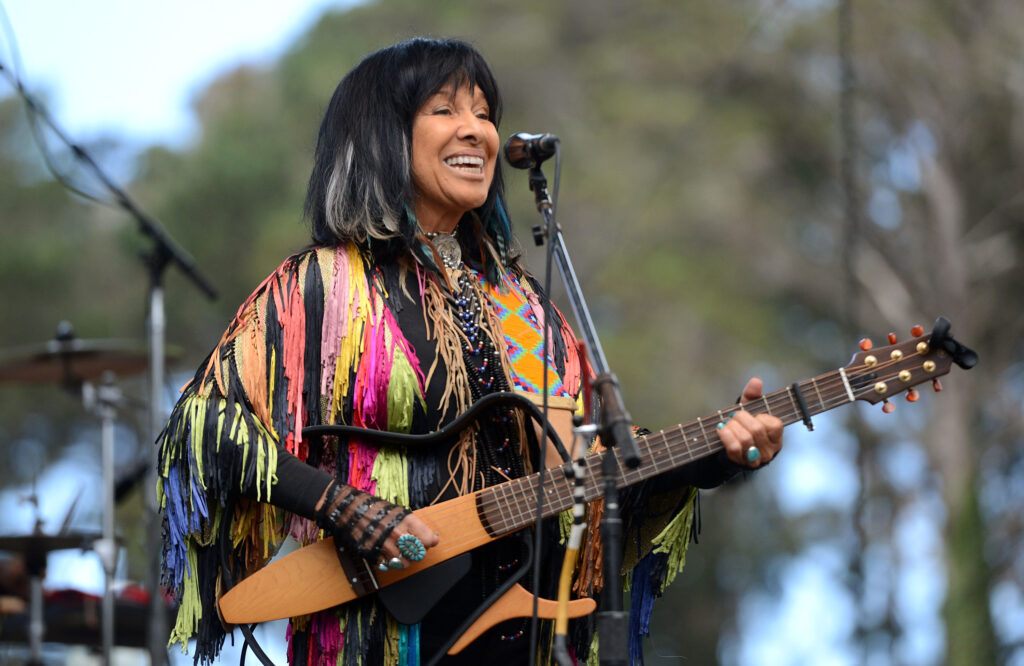Buffy Sainte-Marie is being accused of spreading around a lot of disinformation.
As a self-proclaimed proud Cree woman, the Oscar-winning singer-songwriter and social activist has spent her entire career fighting for and focused on the issues facing Indigenous peoples in the United States and Canada.
But a new blockbuster investigation by the Canadian Broadcast Corporation claims that Sainte-Marie is nothing but a fake.
From the beginning, Sainte-Marie, 82, professed that she was born on a Piapot Cree reservation in Canada and later adopted by Albert and Winifred Santamaria, who raised her near Boston, Massachusetts.
“When I go home to the Cree reserve in Canada where I was born, I usually spend a few hours of every day teaching the Cree language,” she wrote in 1971’s “Buffy Sainte-Marie Songbook.”
She repeated the claims of her heritage during an interview with the LA Times magazine, saying: “I was born on the Piapot Cree reservation near Craven, Sask.”
Yet, several members of Sainte-Marie’s family have stepped forward to challenge these claims.
“She wasn’t born in Canada.… She’s clearly born in the United States,” said Heidi St. Marie, daughter of Sainte-Marie’s older brother, Alan. “She’s clearly not Indigenous or Native American.”
Here’s five things you should know about Buffy Sainte-Marie, the singer accused of faking her indigenous roots.
She’s being labeled a “Pretendian”
Freelance journalist Jacqueline Keeler exposed Sainte-Marie and labeled her a “Pretendian,” or a “pretend Indian,” after watching a PBS documentary on the singer in Fall 2022.
“I’m just like: ‘Wait a minute. This is just like those stories I hear Pretendians tell,’” said Keeler in the CBS report. “She has an adoption story which has no proof.
Keeler, who has faced criticism because of her focus on exposing Pretendians, is Yankton Sioux, a member of the Navajo nation and found Sainte-Marie’s stories regarding her childhood to be vague.
“It just sounded fake,” she said.
After doing some research she was able to track down Sainte-Marie’s birth certificate (something the “Universal Singer” herself said did not exist) from Stoneham town hall for just $22.
After traveling to Stoneham, Mass., to see the birth certificate in person, Keller was shocked to discover that the handwritten document proved that Sainte-Marie was born Beverley Jean Santamaria on Feb. 20, 1941 to Albert and Winifred Santamaria in Stoneham, Mass. at New England Sanatorium.
“This is the original that came from the hospital,” said town clerk Maria Sagarino. “There’s no refuting this because it’s in my custody from my files in my vault. It doesn’t appear that she was adopted in any way, shape or form.”
She knew how to get to “Sesame Street”
On the December 9, 1975 episode of the hit children’s series “Sesame Street,” Sainte-Marie made history when she helped launch the PBS program’s newfound dedication to spotlight the Indigenous culture for their viewers.
On her first episode Sainte-Marie showed off jewelry, clothing and beaded moccasins that she claimed was from her ancestors.
“This is Cree Indian,” she said. “Cree Indians are my tribe, and we live in Canada.”
The “You Got To Run” singer became a semi-regular on the show for five years until 1981. In 1977 she breastfed her son Dakota “Cody” Starblanket Wolfchild and was the first woman to breastfeed on “Sesame Street” in 1977.
And the Oscar goes to …
Sainte-Marie became the first Indigenous person to win an Oscar, when she won the Academy Award in 1983, for co-writing “Up Where We Belong” with songwriter Will Jennings (“Tears in Heaven,” “My Heart Will Go On”) and Jack Nitzche, whom she also married the same year.
The award-winning rack appeared on the soundtrack for the movie “An Officer and a Gentleman.” Recorded by Joe Cocker and Jennifer Warnes, it debuted on the Billboard Hot 100 list and spent three weeks in the number one spot.
In 2013 however she revealed the statuette was not in her possession. “Right now my Oscar is in the Smithsonian, she told Dazed, “because I’m the first Native American, I think the only, to win an Oscar.”
She has Canada’s stamp of approval
In 2021, she appeared on a Canadian stamp, following in the footsteps of a number of legendary musicians including Joni Mitchell, Bryan Adams, Leonard Cohen, Édith Butler, Stompin’ Tom Connors and Rush.
“It feels like an embrace. It feels like it comes from more than only my own family or my own show-business people that I know — it feels like a national kind of thing,” Sainte-Marie told CBC News at the time.
The image used for the stamp was taken by photographer Simon Fowler for the cover of her single “The Big Ones Get Away,” from the 1992 album “Coincidence and Likely Stories.”
She issued a statement declaring “I don’t know where I am from” before CBC’s blockbuster report hit
In a letter to the CBC sent in September, Sainte-Marie’s lawyer, Josephine de Whytell, was seemingly playing damage control and wrote that his client “has never claimed to know exactly where she is from.”
This sentiment was echoed when Sainte-Marie released video and written statements that claimed that her “growing-up Mom” told her that she was adopted and was Native.
“For sixty years I have been sharing my story as I know it,” she began. “I am an artist, an activist, a mom, a survivor and a proud member of the native community with deep roots in Canada. And I count myself lucky to have had two families to love. A growing up family who were wonderful and my Piapot family who are also wonderful.”
“I don’t know where I’m from, who my birth parents are or how I ended up a misfit in a typical, white, Christian New England town,” Sainte-Marie added. “Which is why to be questioned in this way today is painful, both for me, and for my two families I love so dearly.”

